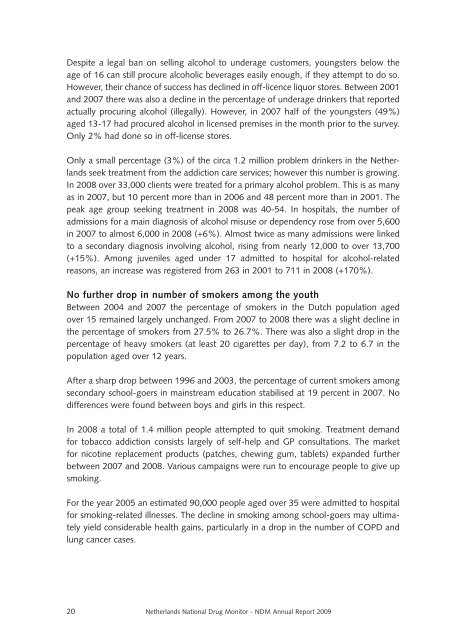Netherlands National Drug Monitor - Research and Documentation ...
Netherlands National Drug Monitor - Research and Documentation ...
Netherlands National Drug Monitor - Research and Documentation ...
You also want an ePaper? Increase the reach of your titles
YUMPU automatically turns print PDFs into web optimized ePapers that Google loves.
Despite a legal ban on selling alcohol to underage customers, youngsters below the<br />
age of 16 can still procure alcoholic beverages easily enough, if they attempt to do so.<br />
However, their chance of success has declined in off-licence liquor stores. Between 2001<br />
<strong>and</strong> 2007 there was also a decline in the percentage of underage drinkers that reported<br />
actually procuring alcohol (illegally). However, in 2007 half of the youngsters (49%)<br />
aged 13-17 had procured alcohol in licensed premises in the month prior to the survey.<br />
Only 2% had done so in off-license stores.<br />
Only a small percentage (3%) of the circa 1.2 million problem drinkers in the <strong>Netherl<strong>and</strong>s</strong><br />
seek treatment from the addiction care services; however this number is growing.<br />
In 2008 over 33,000 clients were treated for a primary alcohol problem. This is as many<br />
as in 2007, but 10 percent more than in 2006 <strong>and</strong> 48 percent more than in 2001. The<br />
peak age group seeking treatment in 2008 was 40-54. In hospitals, the number of<br />
admissions for a main diagnosis of alcohol misuse or dependency rose from over 5,600<br />
in 2007 to almost 6,000 in 2008 (+6%). Almost twice as many admissions were linked<br />
to a secondary diagnosis involving alcohol, rising from nearly 12,000 to over 13,700<br />
(+15%). Among juveniles aged under 17 admitted to hospital for alcohol-related<br />
reasons, an increase was registered from 263 in 2001 to 711 in 2008 (+170%).<br />
No further drop in number of smokers among the youth<br />
Between 2004 <strong>and</strong> 2007 the percentage of smokers in the Dutch population aged<br />
over 15 remained largely unchanged. From 2007 to 2008 there was a slight decline in<br />
the percentage of smokers from 27.5% to 26.7%. There was also a slight drop in the<br />
percentage of heavy smokers (at least 20 cigarettes per day), from 7.2 to 6.7 in the<br />
population aged over 12 years.<br />
After a sharp drop between 1996 <strong>and</strong> 2003, the percentage of current smokers among<br />
secondary school-goers in mainstream education stabilised at 19 percent in 2007. No<br />
differences were found between boys <strong>and</strong> girls in this respect.<br />
In 2008 a total of 1.4 million people attempted to quit smoking. Treatment dem<strong>and</strong><br />
for tobacco addiction consists largely of self-help <strong>and</strong> GP consultations. The market<br />
for nicotine replacement products (patches, chewing gum, tablets) exp<strong>and</strong>ed further<br />
between 2007 <strong>and</strong> 2008. Various campaigns were run to encourage people to give up<br />
smoking.<br />
For the year 2005 an estimated 90,000 people aged over 35 were admitted to hospital<br />
for smoking-related illnesses. The decline in smoking among school-goers may ultimately<br />
yield considerable health gains, particularly in a drop in the number of COPD <strong>and</strong><br />
lung cancer cases.<br />
20 <strong>Netherl<strong>and</strong>s</strong> <strong>National</strong> <strong>Drug</strong> <strong>Monitor</strong> - NDM Annual Report 2009




